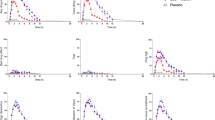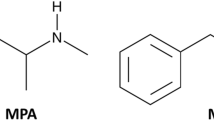Abstract
Rationale
Minocycline, a tetracycline antibiotic, interacts with brain glutamate and dopamine neurotransmission. In preclinical studies, minocycline attenuated amphetamine-induced acute dopamine release and subsequent behavioral sensitization. The goal of this study was to determine minocycline’s effects on the acute physiological, behavioral, and subjective responses to dextroamphetamine (DAMP) in healthy volunteers.
Methods
Ten healthy volunteers participated in an outpatient double-blind, placebo-controlled, crossover study. Subjects had a 5-day treatment period with either minocycline (200 mg/day) or placebo and then were crossed over for 5 days of the other treatment. After 2 days of taking the study medication, on days 3 and 4, subjects were randomly assigned to double-blind acute challenge with either 20 mg/70 kg DAMP or placebo DAMP (randomly labeled as drug A or B) and then crossed over to the other challenge. On day 5 (experimental session 3), subjects had the opportunity to self-administer either placebo or DAMP capsules by working on a progressive ratio computer task.
Results
Minocycline attenuated DAMP-induced subjective rewarding effects but did not change DAMP choice behavior. Minocycline treatment speeded reaction times on a Go No-Go task and reduced plasma cortisol levels.
Conclusions
These findings warrant further studies examining the potential use of minocycline for stimulant addiction.




Similar content being viewed by others
References
Bardo MT (1998) Neuropharmacological mechanisms of drug reward: beyond dopamine in the nucleus accumbens. Crit Rev Neurobiol 12:37–67
Brauer LH, de Wit H (1996) Subjective responses to d-amphetamine alone and after pimozide pretreatment in normal, healthy volunteers. Biol Psychiatry 39:26–32
Chaves C, Marque CR, Trzesniak C, Machado de Sousa JP, Zuardi AW, Crippa JA, Dursun SM, Hallak JE (2009) Glutamate-N-methyl-d-aspartate receptor modulation and minocycline for the treatment of patients with schizophrenia: an update. Braz J Med Biol Res 42:1002–1014
Chen H, Uz T, Manev H (2009) Minocycline affects cocaine sensitization in mice. Neurosci Lett 452:258–261
Cornish JL, Kalivas PW (2000) Glutamate transmission in the nucleus accumbens mediates relapse in cocaine addiction. J Neurosci 20: RC89 (1–5)
Di Ciano P, Everitt BJ (2001) Dissociable effects of antagonism of NMDA and AMPA/KA receptors in the nucleus accumbens core and shell on cocaine-seeking behavior. Neuropsychopharmacology 25:341–360
Dudish-Poulsen SA, Hatsukami DK (1997) Dissociation between subjective and behavioral responses after cocaine stimuli presentations. Drug Alcohol Depend 47:1–9
Fillmore MT, Rush CR, Marczinski CA (2003) Effects of d-amphetamine on behavioral control in stimulant abusers: the role of prepotent response tendencies. Drug Alcohol Depend 71:143–152
Fujita Y, Ishima T, Kunitachi S, Hagiwara H, Zhang L, Iyo M, Hashimoto K (2008) Phencyclidine-induced cognitive deficits in mice are improved by subsequent subchronic administration of the antibiotic drug minocycline. Prog Neuropsychopharmacol Biol Psychiatry 32:336–339
Gonzalez JC, Egea J, Del Carmen GM, Fernandez-Gomez FJ, Sanchez-Prieto J, Gandia L, Garcia AG, Jordan J, Hernandez-Guijo JM (2007) Neuroprotectant minocycline depresses glutamatergic neurotransmission and Ca(2+) signalling in hippocampal neurons. Eur J Neurosci 26:2481–2495
Gordon PH, Moore DH, Miller RG, Florence JM, Verheijde JL, Doorish C, Hilton JF, Spitalny GM, MacArthur RB, Mitsumoto H, Neville HE, Boylan K, Mozaffar T, Belsh JM, Ravits J, Bedlack RS, Graves MC, McCluskey LF, Barohn RJ, Tandan R (2007) Efficacy of minocycline in patients with amyotrophic lateral sclerosis: a phase III randomised trial. Lancet Neurol 6:1045–1053
Grady TA, Broocks A, Canter SK, Pigott TA, Dubbert B, Hill JL, Murphy DL (1996) Biological and behavioral responses to d-amphetamine, alone and in combination with the serotonin3 receptor antagonist ondansetron, in healthy volunteers. Psychiatry Res 64:1–10
Haney M, Spealman R (2008) Controversies in translational research: drug self-administration. Psychopharmacology (Berl) 199:403–419
Hashimoto K (2009) Emerging role of glutamate in the pathophysiology of major depressive disorder. Brain Res Rev 61:105–123
Hashimoto K, Tsukada H, Nishiyama S, Fukumoto D, Kakiuchi T, Iyo M (2007) Protective effects of minocycline on the reduction of dopamine transporters in the striatum after administration of methamphetamine: a positron emission tomography study in conscious monkeys. Biol Psychiatry 61:577–581
Imbesi M, Uz T, Manev R, Sharma RP, Manev H (2008) Minocycline increases phosphorylation and membrane insertion of neuronal GluR1 receptors. Neurosci Lett 447:134–137
Itzhak Y, Ali SF (2006) Role of nitrergic system in behavioral and neurotoxic effects of amphetamine analogs. Pharmacol Ther 109:246–262
Jonas M, Cunha BA (1982) Minocycline. Ther Drug Monit 4:137–145
Kalivas PW (2007) Cocaine and amphetamine-like psychostimulants: neurocircuitry and glutamate neuroplasticity. Dialogues Clin Neurosci 9:389–397
Kim SS, Kong PJ, Kim BS, Sheen DH, Nam SY, Chun W (2004) Inhibitory action of minocycline on lipopolysaccharide-induced release of nitric oxide and prostaglandin E2 in BV2 microglial cells. Arch Pharm Res 27:314–318
Knackstedt LA, Kalivas PW (2009) Glutamate and reinstatement. Curr Opin Pharmacol 9:59–64
Kofman O, Klein E, Newman M, Hamburger R, Kimchi O, Nir T, Shimon H, Belmaker RH (1990) Inhibition by antibiotic tetracyclines of rat cortical noradrenergic adenylate cyclase and amphetamine-induced hyperactivity. Pharmacol Biochem Behav 37:417–424
Kofman O, van Embden S, Alpert C, Fuchs I (1993) Central and peripheral minocycline suppresses motor activity in rats. Pharmacol Biochem Behav 44:397–402
Koob GF (1992) Neural mechanisms of drug reinforcement. Ann NY Acad Sci 654:171–191
Lampl Y, Boaz M, Gilad R, Lorberboym M, Dabby R, Rapoport A, Anca-Hershkowitz M, Sadeh M (2007) Minocycline treatment in acute stroke: an open-label, evaluator-blinded study. Neurology 69:1404–1410
Leigh PN, Meininger V, Bensimon G, Cudkowicz M, Robberecht W (2008) Minocycline for patients with ALS. Lancet Neurol 7:119–120, author reply 120-1
Levkovitz Y, Levi U, Braw Y, Cohen H (2007) Minocycline, a second-generation tetracycline, as a neuroprotective agent in an animal model of schizophrenia. Brain Res 1154:154–162
Levkovitz Y, Mendlovich S, Riwkes S, Braw Y, Levkovitch-Verbin H, Gal G, Fennig S, Treves I, Kron S (2009) A double-blind, randomized study of minocycline for the treatment of negative and cognitive symptoms in early-phase schizophrenia. J Clin Psychiatry 71:138–149
Martin WR, Sloan JW, Sapira JD, Jasinski DR (1971) Physiologic, subjective, and behavioral effects of amphetamine, methamphetamine, ephedrine, phenmetrazine, and methylphenidate in man. Clin Pharmacol Ther 12:245–258
McNair D, Lorr M, Dropperman L (1971) Manual for profile of mood states. Educational and industrial testing services, Educational and industrial testing services
Mizoguchi H, Takuma K, Fukakusa A, Ito Y, Nakatani A, Ibi D, Kim HC, Yamada K (2008) Improvement by minocycline of methamphetamine-induced impairment of recognition memory in mice. Psychopharmacology (Berl) 196:233–241
Molina-Hernandez M, Tellez-Alcantara NP, Perez-Garcia J, Olivera-Lopez JI, Jaramillo-Jaimes MT (2008) Antidepressant-like actions of minocycline combined with several glutamate antagonists. Prog Neuropsychopharmacol Biol Psychiatry 32:380–386
Munzar P, Li H, Nicholson KL, Wiley JL, Balster RL (2002) Enhancement of the discriminative stimulus effects of phencyclidine by the tetracycline antibiotics doxycycline and minocycline in rats. Psychopharmacology (Berl) 160:331–336
Patchev VK, Karalis K, Chrousos GP (1994) Effects of excitatory amino acid transmitters on hypothalamic corticotropin-releasing hormone (CRH) and arginine-vasopressin (AVP) release in vitro: implications in pituitary-adrenal regulation. Brain Res 633:312–316
PDR (2009) Physicians’ Desk Reference: PDR. Medical Economics Data, Medical Economics Data
Robertson IH, Manly T, Andrade J, Baddeley BT, Yiend J (1997) ‘Oops!’: performance correlates of everyday attentional failures in traumatic brain injured and normal subjects. Neuropsychologia 35:747–758
Sadowski T, Steinmeyer J (2001) Minocycline inhibits the production of inducible nitric oxide synthase in articular chondrocytes. J Rheumatol 28:336–340
Seiden LS, Sabol KE, Ricaurte GA (1993) Amphetamine: effects on catecholamine systems and behavior. Annu Rev Pharmacol Toxicol 33:639–677
Sofuoglu M, Waters AJ, Mooney M, Kosten T (2008a) Riluzole and d-amphetamine interactions in humans. Prog Neuropsychopharmacol Biol Psychiatry 32:16–22
Sofuoglu M, Poling J, Waters A, Sewell A, Hill K, Kosten T (2008b) Disulfiram enhances subjective effects of dextroamphetamine in humans. Pharmacol Biochem Behav 90:394–398
Sofuoglu M, Waters AJ, Mooney M, O’Malley SS (2009) Minocycline reduced craving for cigarettes but did not affect smoking or intravenous nicotine responses in humans. Pharmacol Biochem Behav 92:135–140
Stoops WW, Glaser PE, Fillmore MT, Rush CR (2004) Reinforcing, subject-rated, performance and physiological effects of methylphenidate and d-amphetamine in stimulant abusing humans. J Psychopharmacol 18:534–543
Stoops WW, Lile JA, Fillmore MT, Glaser PE, Rush CR (2005) Reinforcing effects of methylphenidate: influence of dose and behavioral demands following drug administration. Psychopharmacology (Berl) 177:349–355
Tanibuchi Y, Shimagami M, Fukami G, Sekine Y, Iyo M, Hashimoto K (2010) A case of methamphetamine use disorder treated with the antibiotic drug minocycline. Gen Hosp Psychiatry (in press)
The NINDS NET-PD Investigators (2006) A randomized, double-blind, futility clinical trial of creatine and minocycline in early Parkinson disease. Neurology 66:664–671
Thomas MJ, Kalivas PW, Shaham Y (2008) Neuroplasticity in the mesolimbic dopamine system and cocaine addiction. Br J Pharmacol 154:327–342
Tidey JW, O’Neill SC, Higgins ST (2000) d-Amphetamine increases choice of cigarette smoking over monetary reinforcement. Psychopharmacology (Berl) 153:85–92
Tzschentke TM (2001) Pharmacology and behavioral pharmacology of the mesocortical dopamine system. Prog Neurobiol 63:241–320
Tzschentke TM, Schmidt WJ (2003) Glutamatergic mechanisms in addiction. Mol Psychiatry 8:373–382
Ungless MA, Whistler JL, Malenka RC, Bonci A (2001) Single cocaine exposure in vivo induces long-term potentiation in dopamine neurons. Nature 411:583–587
Vezina P, Queen AL (2000) Induction of locomotor sensitization by amphetamine requires the activation of NMDA receptors in the rat ventral tegmental area. Psychopharmacology (Berl) 151:184–191
Volkow ND, Wang GJ, Fowler JS, Logan J, Gatley SJ, Hitzemann R, Chen AD, Dewey SL, Pappas N (1997) Decreased striatal dopaminergic responsiveness in detoxified cocaine-dependent subjects. Nature 386:830–833
Zhang L, Kitaichi K, Fujimoto Y, Nakayama H, Shimizu E, Iyo M, Hashimoto K (2006) Protective effects of minocycline on behavioral changes and neurotoxicity in mice after administration of methamphetamine. Prog Neuropsychopharmacol Biol Psychiatry 30:1381–1393
Ziegler DR, Cullinan WE, Herman JP (2005) Organization and regulation of paraventricular nucleus glutamate signaling systems: N-methyl-d-aspartate receptors. J Comp Neurol 484:43–56
Acknowledgments
This research was supported by the Veterans Administration Mental Illness Research, Education and Clinical Center (MIRECC), and National Institute on Drug Abuse (NIDA) grants P50-DA12762, K05-DA0454 (TK), K02-DA021304 (MS), and K01-DA-019446 (MM).
We would like to thank Ellen Mitchell, R.N. and Stacy Minnix for the technical assistance.
Conflict of interest
Dr. Kosten is in the Speakers Bureau of Reckitt. He served as a consultant for Celtic, Alkermes, Synosia, Catalyst, and Gerson Lerman and has ownership interests with Pfizer and Johnson & Johnson. Dr. Mooney has received research grants from Pfizer. None of the products of these companies are associated with this work. The other authors have no conflicts of interest.
Author information
Authors and Affiliations
Corresponding author
Rights and permissions
About this article
Cite this article
Sofuoglu, M., Mooney, M., Kosten, T. et al. Minocycline attenuates subjective rewarding effects of dextroamphetamine in humans. Psychopharmacology 213, 61–68 (2011). https://doi.org/10.1007/s00213-010-2014-5
Received:
Accepted:
Published:
Issue Date:
DOI: https://doi.org/10.1007/s00213-010-2014-5




